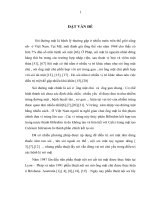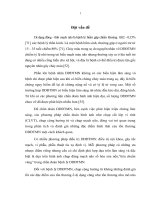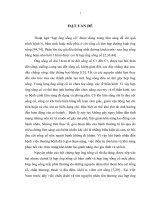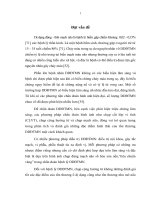Protocols chụp cộng hưởng từ
Bạn đang xem bản rút gọn của tài liệu. Xem và tải ngay bản đầy đủ của tài liệu tại đây (356.6 KB, 11 trang )
BODY MRI
PROTOCOLS
Updated
06/04/2014
Abdomen
**No post contrast subtraction images unless specified
in protocol**
Limited abdomen and pelvis
(cancer surveillance, non-specific clinical history)
/>
1. Localizer
2. asset calibration
3. axial in-phase/out-of-phase pelvis
4. axial T2 FS SSFSE pelvis
5. axial 3D LAVA pre- pelvis
6. axial in-phase/out-of-phase abdomen
7. axial T2 SSFSE abdomen
8. coronal T2 SSFSE abdomen
9. axial 3d LAVA pre- abdomen
10. axial 3D arterial LAVA abdomen
11. axial 3D venous LAVA abdomen
12. axial 3D LAVA delayed pelvis
Basic abdomen
/>
1. Localizer
2. asset calibration
3. Coronal SSFSE T2
4.Axial FRE T2 respiratory triggered /or FRFSE-XL T2 breath hold
5. Axial in-phase/out-of-phase
7. Axial / coronal 3D lava pre8. Axial 3D LAVA post dynamic
9. Coronal 3D LAVA post delayed
Liver (40 min)
Axial T1 I/O phase
Axial T2 BH FRFSE
Axial T2 BH FRFSE w/ FS
Coronal T2 SSFSE
Axial LAVA/FAME w/FS pre Gad
Axial LAVA/FAME w/FS post Gad at 30 seconds, 1 & 3 minutes
Need subtraction images for each post gado acquisition
7. Coronal LAVA/FAME w/FS post Gad at 5 minutes
8. Diffusion axial x 2. b value of 50 and 750.
1.
2.
3.
4.
5.
6.
EOVIST LIVER (40 min)
1.
2.
3.
4.
SSFSE-axial
SSFSE-Coronal
Dual ECHO –In and Out of Phase: Axial
LAVA pre-axial
GAD
5.
6.
7.
8.
9.
10.
LAVA: 2 phase injection: (Dynamic)
a.
Need subtraction images
LAVA: Axial 70sec delayed
a.
Need subtraction images
LAVA: Axial 3min delayed
a.
Need subtraction images
LAVA: Coronal 4min delayed
LAVA: Axial 5 min delayed
LAVA: Axial and Coronal 20 min delayed
MRCP (25 min)
NPO 4 hours prior
Arrive 20- 30 minutes early for 150-300 ml of po pineapple juice or
Gastromark
1.
2.
3.
4.
5.
Axial T1 I/O phase
Axial T2 SSFSE
Coronal T2 SSFSE
Thick Slab SSFSE – 4 oblique planes through panc/CBD/GB, 40mm thick
Coronal 3D Volume Respiratory triggered MRCP***
a. Thin coronal MIP images created from this (1.6/0.8)
b. Thin axial MIP images created from this (1.6/0.8)
***Do breath hold acquisition if the respiratory trigger is poor***
If secretin exam:
Secretin (optional)
adults: 0.2µg/kg IV slowly over 1 minute
pediatric: 0.2 μg/kg (maximum dose, 16 μg)
Administer secretin by angio RN- IV push
6.
Thick slab SSFSE through plane of pancreatic duct every minute for 10 minutes
(stacked)
Liver for Hemochromatosis
**Should be done on 1.5 T magnet
1.
2.
3.
4.
5.
Axial GRE 90 degree flip TE 4.0
Axial GRE 20 degree flip TE 4.0
Axial GRE 20 degree flip TE 9.0
Axial GRE 20 degree flip TE 14.0
Axial GRE 20 degree flip TE 21.0
Pancreas (40 min)
Patient Prep: NPO for 4 hours,
If MRCP is NOT requested, give pat 750cc of water starting 60 min prior to exam
1. SSFSE Axial
2. SSFSE Coronal
3. T1 I/O phase
4. Axial T2 FSE w/ FS
5. Axial LAVA/FAME w/FS pre Gad
6. Axial LAVA/FAME w/FS post Gad x/x at 35 seconds, 70 seconds, 3 minutes
7. Coronal LAVA/FAME w/FS post Gad at 3 minutes
Adrenal: (40 min)
Coverage- diaphragm to aortic bifurcation
If clinical question is adrenal adenoma, then call rad to check after in-phase/opposedphase series
1. SSFSE- Coronal –diaphragm to aortic bifurcation
2. T1 GRE (In & Out of Phase) : Axial (adrenals) 3-4mm slice thickness
3. T1 GRE (In & Out of Phase) : Coronal (adrenals) 3-4mm slice thickness
4. T2 FSE with FS: axial -diaphragm to aortic bifurcation
5. Axial LAVA/FAME w/FS pre Gad diaphragm to aortic bifurcation
6. Axial LAVA/FAME w/FS post Gad at 35s, 70s (diaphragm to bifurcation)
7. Coronal LAVA/FAME w/FS post Gad at 3 minutes
Renal for Mass (60 min)
Field of view limited to kidneys
1.
2.
3.
4.
5.
6.
7.
8.
9.
Axial T1 I/O phase
Coronal T2 SSFSE
Axial T2 SSFSE
Axial T2 SSFSE w/FS
Axial LAVA pre Gad
Sagittal LAVA of each kidney pre Gad
Coronal LAVA pre Gad
Coronal LAVA post Gad at 25/90 seconds
Sagittal LAVA post Gad of each kidney
Axial LAVA post Gad
** if the patient cannot receive gadolinium, please obtain:
11. Diffusion axial x 2. b value of 50 and 750.
10.
MR Urogram
Pediatric Radiology 2008, MR urography in children: how we do it 38 (Suppl 1)S3-S17.
Have patient arrive 1 hour prior to get IVF
Patient prep: Empty bladder prior to getting on table
Adult: 500cc NS bolus IMMEDIATELY BEFORE scan
Pediatric: weight based IVF per article pg S4:
4ml/kg/hr 1st 10 kg
2ml/kg/hr next 10 kg
1ml/kg/hr for each kg above 20 kg
Adults: patient to arrive 1 prior to angio in RR for IV placement, hang fluids, possible
catheter placement (optional). **Lasix dose: 20-40 mg slow IV push
Pediatrics: need Pain Free and catheter (can administer Lasix). **Laxis dose: 1 mg/kg
(up to max dose 20mg) slow IV push.
1. SSFSE: Coronal Abd and pelvis
2. Axial FS T1 Abd and pelvis
3. Axial T2 FSE Abd and pelvis
4. Axial T2 FSE w/FS Abd and pelvis
5. Coronal T2 FSE w/FS Abd and pelvis
LASIX
1. Coronal T2 SSFSE Thin section (1 mm) respiratory triggered Kidneys/Ureters
(MRCP type, for stagnant fluid, i.e. obstruction) with 3D reconstruction.
2. Coronal LAVA pre Gad
Post Contrast:
3. Dynamic 3-D GRE in coronal oblique plane to include kidneys and bladder, 2 mm
slice thickness. Automatic MIP images of each volume acquired. Do dynamic
scanning with timing of scan acquisition: arterial phase (~30 seconds), Portal
venous phase (~60 sec), nephrographic (~100 sec), excretory phase (~8 minutes).
*** have rad check***
4. Coronal LAVA post Gad in excretory phase (~ 8 min), (need to see ureters to
bladder) have rad check. 3D recon.
5. Sag 10 min LAVA post Gd of each kidney
Use Ablavar for ALL MRAs
Renal MRA (60 min)
Coronal SSFSE- to determine anatomy and location of kidneys
Axial FrFSE T2 BH-fat sat
FIESTA –Axial (gated multiphase)
FIESTA -Coronal
Optional 3D TOF (if can’t get Gad)
Dry Run MRA
Renal MRA w/Gado- Coronal 3D acquisition
a. Reformat into thin axial and coronals
8. Axial FMPSPGR w/FS post Gad
9. Coronal FMPSPGR w/FS at 5 minutes
10. 3D Phase contrast
1.
2.
3.
4.
5.
6.
7.
Aorta (Chest/Abd/Pelvis) – (60 min)
Axial DIR-Peripheral Gated
Axial FIESTA-gated
Sagittal-Oblique FIESTA-gated
MRA Dry Run
MRA w/Gado- Saggital Oblique (Candy-Cane) 3D acquisition
a. Reformat into thin axials
6. Axial FMPSPGR w/FS post Gado
1.
2.
3.
4.
5.
Enterography (60 min)
Volumen, 3 bottles, 90 minutes prior to study,
need to give glucagon to slow peristalsis, give 1 mg IM after thick slab coronals.
1.
2.
3.
4.
5.
6.
7.
8.
Thick Slab Coronals (MRCP like, 40mm FOV, 4-5 stations anterior to posterior to
cover all small bowel, 5 images per station [to view, sort images by table
position])
Coronal 2D FIESTA
Coronal T2 SSFSE BH
Axial T2 BH w and w/o FS
Axial LAVA pre
Coronal LAVA pre
Coronal LAVA post Gad at 35 and 70 seconds
Axial LAVA post Gad
Pelvis
Anal fistula protocol
Preferably on 3T
Sag T2 FRFSE (Full FOV, 2.5mm/gap 0)
*Use to establish oblique planes -axial and coronal to long axis of anal canal. MD
to check planes if unsure.
Smaller FOV 26 cm:
Obl axial T1 FSE pre (4mm/gap 0.8)
Obl axial T2 fat sat FRFSE (4mm/gap 0.8)
Obl axial T2 FRFSE (4mm/gap 0.8)
Obl coronal T2 fat sat FRFSE (4mm/gap 0.8)
Obl axial fat sat FSPGR post (4mm/gap 0.8)
Obl coronal fat sat FSPGR post (4mm/gap 0.8)
MRV Pelvis DVT/May Thurner (occult stroke with PFO)
Use ablavar. Do not use TRICKS
1. 2d TOF
2. SPRGR pre- post gad
3. 3D MRV (venography): Scan in 3 phases, the first after a 120sec fixed time
delay.
a. Reformat each phase into thin axials and sagittals
4. Axial LAVA T1FS post gado
Female Pelvis (60 min slot for GAD, NO Gad 40min)
Planes in relation to uterus for uterine pathology, otherwise in relation to pelvis
For uterine pathology:
axials
coronal
s
1.
2.
3.
4.
5.
6.
7.
SSFSE Coronal Abd and pelvis
Axial T1 whole pelvis
Axial T1 FSE Fat Sat (with superior and inferior sat bands) – small FOV
Axial T2-small FOV
Sagittal T2 (uterine evaluation ) small FOV
Sagittal T2 with Fat Sat
Axial T2 w/FS- small FOV
If question malignancy, add:
8.
9.
10.
11.
Axial FSPGR w/FS
Axial FSPGRw/FS post Gad
Coronal FSPGR w/FS post Gad
Sagittal FSPGR w/FS post Gad
Female Pelvis Mullerian protocol:
Planes for small field of view images in relation to uterus as per above image.
1.
2.
3.
4.
5.
6.
T2 FSE axial FS full FOV
T1 FSE axial full FOV
T2 FSE saggital (in relation to the uterus) small FOV 4mm/slice
T2 FSE axial (in relation to the uterus) small FOV 4mm/slice
T2 FSE coronal (in relation to the uterus) small FOV 4mm/slice
SSFSE/HASTE/TruFISP coronal to include kidneys 7mm/slice (abd/pelvis same
field of view as in enterography)
Female Pelvis Urethral protocol: 60 min
1.
Coronal SSFSE: wide FOV to include kidneys
2.
3.
4.
3 plane T2 Fat Sat- 18-24cm FOV to be centered on the urethra
Axial T1 Fat Sat-18-24 small FOV
Gad if requested by the MD for infection, inflammation, or malignancy
a. Axial T1FS in 3 planes
Cervical cancer staging protocol:
T1 FSE axial upper abdomen and pelvis
T2 FSE FS axial full FOV pelvis
T2 FSE saggital pelvis small FOV pelvis
T2 FSE axial oblique small FOV pelvis (short axis of the cervix)
Radiographics 2007 AJR 2007; 188:1577–1587
Endometrial cancer staging protocol:
1.
2.
3.
4.
5.
T1 FSE axial upper abdomen and pelvis
T2 FSE FS full FOV axial pelvis
T2 FSE saggital small FOV
T2 FSA axial oblique (short axis of the uterus) small FOV
T1 weighted 3D Gradient echo small FOV:
a. saggital at 0,1,3,5min
b. axial (short axis) 4min
Radiographics 2007 AJR 2007; 188:1577–1587
Prostate (40 min)- 2 separate protocols
1. For staging or XRT planning (*no diffusion)
1. Axial T1 whole pelvis
2. Axial T1
3. T2 FSE 3mm small FOV
a. axial oblique
b. sagittal
c. coronal oblique
4. Axial 3D T2
2. Prostate with contrast and diffusion (Elevated PSA, negative biopsy)
***MUST BE ON 3T/phased array body coil
1.
2.
3.
4.
5.
axial T1 FSE TR/TE 650/10 small FOV(20cm) 3mm/1mm MATRIX 320
T2 axial small FOV(20cm) 3mm/1mm MATRIX 320
T2 sagittal small FOV FSE 3mm/1mm
T2 coronal 5000/93 Echo train 13 small FOV(20cm) 3mm/1mm MATRIX 320
DWI axial TR/TE 6000/78 flip angle 90, nex 6, b-values 0 and 1000, matrix
128x92 FOV 35cm x35cm 3mm/1mm to cover entire prostate and seminal
vesicles
Contrast sequences
1. axial post contrast – rapid dynamic contrast enhanced
Slice thickness 4.0/0.0, sequential 16 axial slices, 20 phase acquisition
FOV 22
/>
Pregnant R/O Appendicitis (40 min)
1.
2.
3.
4.
5.
6.
7.
SSFSE-Coronal
SSFSE-Axial
Sagittal T2 SSFSE
T2 Breath Hold with Fat Sat-coronal
T2 Breath Hold with Fat Sat- axial
FIESTA : Coronal
FIESTA: Axial (optional) – if ? kidney stone
Defecography (40 min)
1.
2.
3.
4.
5.
6.
7.
8.
Axial T2 SSFSE
Sagittal T2 SSFSE to obtain midline
Sagittal FIESTA at Rest
Sagittal FIESTA with minimal straining
Sagittal FIESTA with moderate straining
Sagittal FIESTA with maximum straining
Sagittal FIESTA with Kegel
Sagittal FIESTA with defecation
Fetal MRI (60 min)
1.
2.
3.
4.
5.
Axial T2 SSFSE
Sagittal T2 SSFSE
Coronal T2 SSFSE
Axial FIESTA
Coronal FIESTA
6.
Sagittal FIESTA
Can add T1s for blood, esp in brain.
Rectal cancer staging protocol
3T during day preferably to be monitored by a Radiologist
Oblq
axial
MR technologist: if you
are uncertain about the oblq
axial and coronals, or if the
tumor involves the rectum as it
curves, call MD to help select
the best imaging planes.
Oblq
coronal
1. Sagittal large FOV T2 SSFSE for overview and planning of subsequent sequences
5mm/slice
2. T1 TSE axial (with short echo train of 3-5) to look for lymph nodes pelvis up to
the aortic bifurcation 5mm/slice.
3. tumor localization with T2 FSE axial full FOV pelvis 5mm/slice
4. T2 small FOV perpendicular to the long axis of the rectum 3mm/slice
5. T2 small FOV perpendicular to the long axis of the rectum 3mm/slice after rectal
gel
6. T2 small FOV coronal (parallel) to the long axis of the rectum 3mm/slice
7. T2 small FOV coronal (parallel) to the long axis of the anal canal 3mm/slice to
evaluate for sphincter involvement
8. T2 Sagittal small FOV 3mm/slice
Post iv contrast:
9. T1 SPGR axial small FOV perpendicular to the long axis of the rectum 3mm/slice
10. T1 SPGR coronal small FOV parallel to the long axis of the rectum 3mm/slice
11. T1 SPGR sagittal small FOV 3mm/slice









